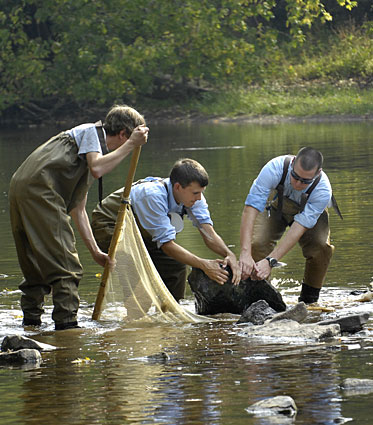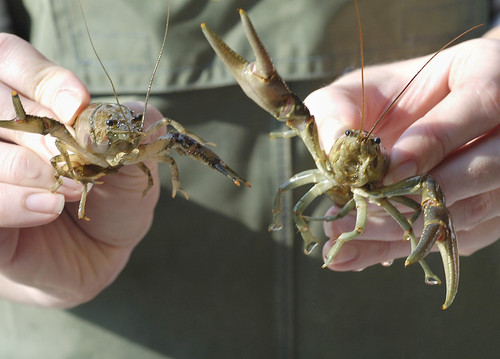
State biologists Pat Ciccotto (left), Matt Ashton and Andy Becker turn over rocks in the Monocacy River looking for rusty crayfish, a large species that has moved south over the Mason-Dixon line. (Sun photo by Jed Kirschbaum / October 17, 2007)

Oct. 18--The rusty crayfish, a mud critter with extra large claws, has sneaked across the Mason-Dixon line from Pennsylvania into a pair of northern Maryland streams, where biologists worry that the invasive species will kill native fish and plants.
State wildlife managers are tracking the southward creep of what some call the "king" of all crawdaddies down the Monocacy River in Frederick County and Conowingo Creek in Cecil County.
Officials at the Maryland Department of Natural Resources think that the crayfish -- often used as bait -- are hitchhiking in the buckets of fishermen. The agency warns that it will start imposing fines of $125 or more this month on anglers who dump bait buckets with exotic species into streams.
"Rusty crayfish are a huge problem, the most notorious of crayfish," said Jay Killian, a DNR biologist, as he waded in hip boots through the scenic Monocacy, trying to net some of the invaders. "They grow really fast, and they eat native crayfish and out-compete them for shelter."
Rusty crayfish are native to the Ohio River valley and are larger and more aggressive than native Maryland species. Midwestern fish and plant life have adapted to them, and predators there keep their numbers in check. But in the Mid-Atlantic region and elsewhere, they have spread; the fish don't eat the rusties -- sometimes because they are just too large for their mouths.
So the crayfish have few natural enemies, and that means their population can explode.
Ronald J. Klauda, director of stream monitoring for the state wildlife agency, said the rusty crayfish can harm fish populations because they gobble up fish eggs and eat the bugs that fish rely on for food. The voracious crayfish also eat lots of aquatic plants.
The discovery in June of hundreds of rusty crayfish in the Monocacy River is the most recent invasion of an exotic aquatic creature caused by people dumping bait buckets or aquarium tanks, state officials said.
The problem has increased recently through the sale of bait and pets over the Internet.
Snakeheads, a predatory fish from Asia, were introduced into the state in 2004 when someone dumped a tank from a Chinese restaurant into a pond in Crofton, according to state officials. Three species of darter fish and exotic worms and minnows have started multiplying in Maryland rivers after fishermen released their extra bait.
An oriental weatherfish -- looking like an odd cross between an eel and a catfish -- was found by state biologists recently in the Gwynns Falls in the Woodlawn area of Baltimore County.
In many cases, exotic species don't survive Maryland's weather or blend in with native creatures. Occasionally, hardy non-native species can help their new environment. The Asian aquarium plant hydrilla is feeding birds in the Potomac River, for example.
But in a few cases, such as that of the oyster-killing parasite MSX that appeared in the Chesapeake Bay in the 1950s, invaders can have devastating effects.
State biologists hope the rusty crayfish won't prove anywhere near that harmful. But in an effort to prevent the worst, they have stepped up their monitoring of the creatures and education of fishermen with a "Don't dump bait buckets" message.
"It's kind of Russian roulette with the exotic species," Killian said. "You never know when they are going to cause real problems."
To discover how far south the crayfish have spread down the Monocacy River, five state biologists yesterday waded into the shallow, rocky stream near an iron bridge on Route 77, west of Detour. Three of the researchers kicked up clouds of silt from the river bottom and turned over stones with their feet. The splashing frightened crayfish from their hiding places into a wide net held by two researchers.
To show the difference between rusty and native crayfish, Killian held up a pair.
He explained that rusty crayfish -- which get their name from the rust-colored spots on their backs -- can grow up to 8 inches long, longer than the 5-inch maximum of most native crayfish. They tend to be light green or brown in color, with claws often twice as big as those of local crayfish.
"This is the rusty crayfish here," Killian said, clutching what looked like a
small green lobster. "You see, very large claws. You can imagine when these guys
do battle with the native crayfish, these big claws come in real handy."

State biologists Pat Ciccotto (left), Matt Ashton and Andy Becker turn
over rocks in the Monocacy River looking for rusty crayfish, a large species
that has moved south over the Mason-Dixon line. (Sun photo by Jed Kirschbaum / October 17, 2007)
